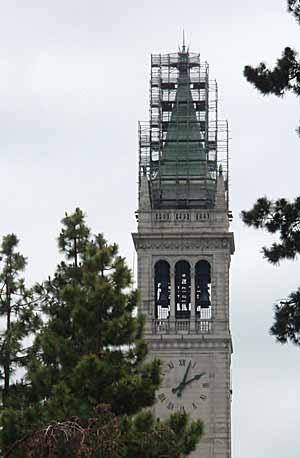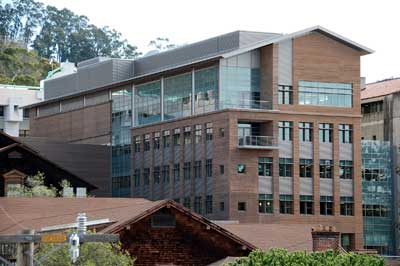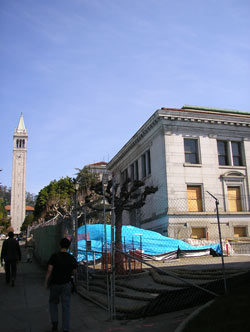Why Berkeley can keep on building during the budget crisis
With funding already in place, the campus can take a long-term perspective on capital projects
| 27 August 2009
BERKELEY — How does the campus continue its renovation and construction projects in the midst of the University of California’s budget crisis? Why doesn’t Berkeley stop spending money to fix old structures and build new ones, and instead allocate those funds to meet operational needs, hold down student fees, and pay employees?
As is often the case with budgetary matters, reality is complex. The money used to run the campus comes from a variety of sources, and much of it is restricted to specific uses. As a general rule, the money used for “capital” — items with long, useful lives, such as buildings and fixed equipment — is largely separate from funding for “operations” — the year-to-year allocation of money the campus gets for salaries, benefits, programs, and the other costs of running the university.
In addition, because the lead time for planning a major project on campus can be from 1 to 3 years, campus construction projects underway today are financed with funds committed years ago, says Paula Milano, acting director of Space Management and Capital Programs.
Long before a shovel hits the ground, a project must be planned and designed, but the financing — often from multiple sources — must also be in place. When state money is involved, the project has to make its way through the California budget process — a long and, as recent experience demonstrates, highly uncertain path. For projects supported largely or entirely with gifts and grants, the campaign to raise the funds required can take years from the initial gift to the final contributions.
Disparate funding sources
Funding for building projects might come from a single source or a combination of funders. Projects in full swing on campus now, such as the four highlighted on this page, offer a primer on the sources of funding for buildings — funding that can’t be redirected, even when a severe budget crunch hits the campus.
Timing is everything
Although these various kinds of funds can’t be used to solve the campus’s current financial problems, it’s not necessarily a bad thing to continue investing in our facilities. Milano suggests taking a long-term perspective on the campus’s capital projects.
“From a financial point of view, it’s a good time to spend money on construction,” she says. “Costs have decreased substantially.” In addition, long-term borrowing rates are near historical lows. For both these reasons, the campus is getting more for the dollars it does spend. Although completing long-planned projects in dire economic times may seem counterintuitive, says Milano, “You want to take advantage of economic conditions and lock in prices now.”
 The Campanile's roof under repair
The Campanile's roof under repairClark Kerr Campus: Auxiliary funds
Auxiliary funds collected by revenue-generating units, such as Parking and Transportation and Residential and Student Service Programs (RSSP), are used for capital projects that support their operations.
For example, RSSP auxiliary funds are going toward a two-year, $97 million renewal and renovation of the Clark Kerr Campus. The work includes upgrades to the campus’s disabled access and safety, with new pathways, lighting, and outside emergency phones; and exterior lighting; improving connections to Berkeley’s computer network; installation of a sprinkler system and upgrades to fire alarms; and replacement of electrical wiring .
The Campanile: Maintenance and repair
The Campanile’s spire is being waterproofed, cleaned, and repaired. Unlike many other capital projects, funding for this maintenance work does come out of the campus’s operating budget. Last year’s restoration of Sather Gate is another example of such maintenance. Berkeley is budgeting approximately $5 million this year for maintenance and repair projects to supplement maintenance funding from the state, which in recent years has ranged from miniscule to zero.
“It would be irresponsible if we didn’t make a continued effort to maintain our facilities,” says Milano. “We’re a very old campus, so we have chosen to spend a modest amount from our operating budget on renewal of this sort to preserve the safety, character, and landmarks of our campus.” The money alloted to such maintenance and repair is a fraction of the campus need, she adds.
 Sutardja Dai Hall
Sutardja Dai HallSutardja Dai Hall: Multi-source funding
“Given the resource constraints of the state and the complex needs of the campus, the majority of our projects going forward will be funded through a combination of funding sources,” says Milano.
One example of such multi-source funding is Sutardja Dai Hall, a new, 141,000-square-foot building facing Hearst Avenue. It houses the Center for Information Technology Research in the Interest of Society (CITRIS) — one of four Governor Gray Davis Institutes for Science and Innovation — and the Banatao Institute@CITRIS. The center brings together researchers and students from four UC campuses — Berkeley, Davis, Merced, and Santa Cruz — with industrial partners from more than 60 corporations to think about new uses for IT.
Because of the nature of its funding, money for this large-scale interdisciplinary project, dedicated last February, could not have been redirected to other uses, says Milano. The Davis Institutes funding was conceived as a matching program: Groups of UC campuses were challenged to compete for state funds to build new centers for research in areas critical to the future state economy, and to match the state contribution with non-state funds. For CITRIS, the state contribution was matched by a combination of gifts and long-term financing backed by research funds.
Strategic use of campus debt — another potential funding resource — is expected to play an increasingly important role in Berkeley’s efforts to accomplish its capital goals. For example, the campus is using a portion of its debt capacity to help fund the new Biomedical Health Sciences Building now in construction at the old Warren Hall site just off Oxford Street.
 Durant Hall
Durant HallDurant Hall: State funds
As a public university, Berkeley receives some money from the state to support facilities used for academic purposes. Since 1997, when the Seismic Action Plan for Facilities Enhancement and Renewal program was launched to retrofit campus structures, Berkeley has dedicated most of its state funding for capital projects to improving the seismic safety of existing structures. Barrows and Barker Halls and the Bancroft Library are some of the many campus buildings that have been made safer with state funds.
Historically, state funds have been the primary source for campus construction projects, although — like state support in general — the percentage of campus building funds that comes from the state has been on the decline in recent years.
Currently undergoing renovation with state funds is Durant Hall, built in 1911 as the first home of Berkeley’s law school. Adjacent to California Hall, the renovated Durant will house the deans and staff of the College of Letters and Science. Before the building reaches its centennial, its interior spaces and systems will be updated, and a sunny plaza with an accessible entry will be built on its west side.
Work began on the project in fall 2008, was suspended last January as California withheld funds until a state budget was passed, and resumed in July.
Can the money for state-financed projects like Durant be used for operating expenses? “The answer is no,” says Milano. If the campus doesn’t use that money for that specific capital project, it reverts back to the UC Office of the President, which must consult with the state on further disposition. Sometimes the state allows the funds to be redirected to other UC capital projects, but it may also require their return to state coffers.

